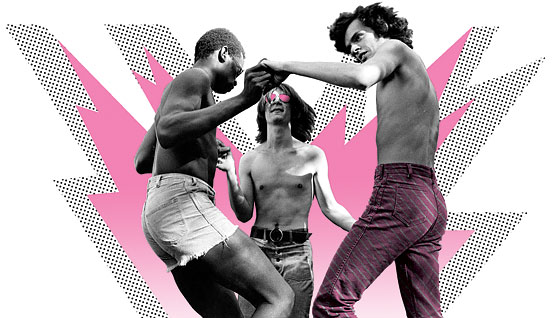
Gay New Yorkers may not have been free in the year of the Stonewall riots, but there was still plenty of fun to be had, with the third annual Gay Scene Guide boasting “over 175 listings … as accurate and up to date as the editor’s kidneys can make it.” The year before, Mart Crowley’s play The Boys in the Band put the secret joys and woes of gay life on the public radar, and, on The Tonight Show, the psychic Criswell predicted that gay enclaves would spring up in cities nationwide. A sampling of what was available.
(*=still open) A gay guide to life in 2009.
TIMES SQUARE
Parts of 42nd Street are “always lively with … scores of hustlers,” noted the Gay Scene Guide. “We understand the going rate (average) being charged by the (again, average) hustler is $10.” Movie theaters were also popular. At the Empire, “old war and adventure films predominate, which attract many of the leather crowd.” The guide did take pains to warn its readers away from the Port Authority.
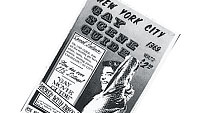
GREENWICH VILLAGE
The Gay Scene Guide praised the neighborhood but cautioned, “do not confuse the ‘hippy set’ with the ‘Gay set.’ There are many hippies in this area, who while they may dress in a ‘gay’ fashion are actually quite opposed to any gay advances.”
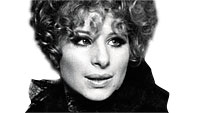
→ Bars
The Bon Soir (40 W. 8th St.)
Barbra Streisand debuted here in 1960, opening for Phyllis Diller. Where “blacks and whites [and] gays and straights mingled without a trace of tension,” says historian James Gavin in Charles Kaiser’s book The Gay Metropolis.
The Bohemian (15 Barrow St.)
GSC: “This one is for GIRLS only.”
The International Stud (733 Greenwich St.)
GSC: “Leather bar … Seldom do you see silk neckerchieves, or Betty Boop curls, on any of its patrons.”
*Julius’ (159 W. 10th St.)
Venerable Village pub, complete with greasy burgers, dates back to the nineteenth century. Became discreetly gay sometime in the fifties. In 1966, four members of the Mattachine Society (see “West Side”) announced they were gay and asked to be served, flouting a common interpretation of state liquor laws that kept bartenders from serving known gays. The “Sip-In” made things easier for gays in bars, but hardly signaled the end of mob ownership and cop raids on more overtly gay venues like the Stonewall Inn. John Cameron Mitchell now hosts a monthly party at Julius’ called “Mattachine.”
Kookie’s (149 W. 14th St.)
Lesbian bar. Wrote historian Joan Nestle in The Feminist Memoir Project: “Kookie herself strode around the floor, blonde hair teased high, keeping track of how fast we emptied our glasses. One night she had stopped at my table and shoved her pinkie into my glass to suggest I needed another drink. Kookie was a businesswoman, and we were her trade.”
Tenth of Always (82 W. 3rd St.)
As David Carter writes in Stonewall: “ an ice-cream parlor run by the Mafia and targeted at gay teenagers.” Dancing was permitted, “but the staff would yell at customers if they even sat close to each other.” When the police stopped by, as they often did, “the Mafia staff would turn on a chandelier as a signal for everyone to stop dancing.”
Sea Colony (Eighth Ave. and Horatio St.)
GSC: “GIRLS’ bar, survivor of every ‘clean-up’ campaign to date.” Wrote Nestle: “I can still peer into the smoke-filled room, feel the pressure of bodies … We needed the lesbian air of the Sea Colony to breathe the life we could not breathe anywhere else … Because we were labeled deviants, our bathroom habits had to be watched. Only one woman at a time was allowed into the toilet … Guarding the entrance was a short, square, handsome butch woman, the same one every night, whose job it was to twist around her hand our allotted amount of toilet paper.”
*The Stonewall Inn (53 W. Christopher St.)
Former restaurant cheaply converted by the mob into a gay dance bar in 1967. Drinks were $1, costly for the time, and mixed with bootleg liquor. Nor was there any running water behind the bar. But there were two dance floors. The back one was “the favored place of the homeless youth, as well as of young blacks and Puerto Ricans,” writes Carter, its jukebox more Motown than Beach Boys. The club may have been uniquely suited to having an uprising because it fronted Christopher Park, a gathering place for gay youth, hippies, and activists. But the June 28 raid and ensuing riot linked the bar permanently with the issue of police corruption, and the Stonewall Inn, its popularity already waning, closed three months later. It’s now a gay bar again.
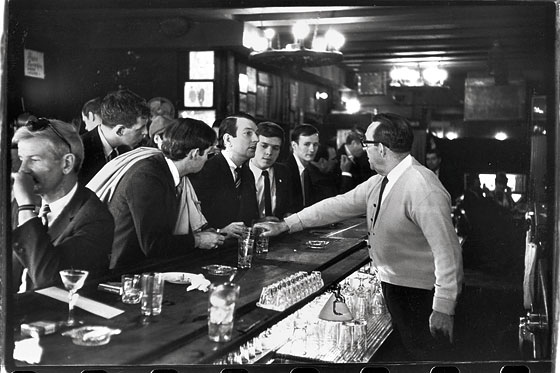
WEST SIDE
→Bars
Candy Store (44 W. 56th St.)
GSC: “Piano bar—very elegant … Someone recently published a comment that his nominees for bars with the most ‘up-tight’ people are Julius’ and the Candy Store.”
→ Baths
Everard Baths (28 W. 28th St.)
GSC: “A number of Gay Guide[s] have incorrectly spelled the name … it is Everard, not EVER HARD!”
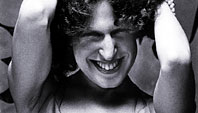
Continental Baths (230 W. 74th St.)
In the basement of the Ansonia, this gay-sex venue also featured the young Bette Midler as a performer. (Several grainy videos on YouTube show her singing such songs as “Hot Stuff,” “Marahuana,” and “I Shall Be Released” and talking about getting her hair done in the 34th Street subway station.) Became Plato’s Retreat, a straight swingers’ club, in 1977; closed in 1985 amid the AIDS crisis.
*Y.M.C.A. (5 W. 63rd St.)
→Community Groups
Mattachine Society Offices (243 West End Ave., at 71st St.)
Founded in 1950 in Los Angeles, it was the best-known gay activist group (albeit a fairly timid one) prior to Stonewall, later supplanted in influence by the more militant Gay Activists Alliance and Gay Liberation Front.
→Cruising
Central Park West (59th St. to 88th St.)
Yes, according to the Gay Scene Guide, that entire stretch of CPW was one big “meat-rack.” The guide also provided some helpful hints for successful canine accessorizing. “If you live in this area, be sure to obtain a mixed-up, odd-looking (I hesitate to say ‘queer-looking’) mongrel. You’ll find it’s a great way to strike up conversations with the neighbors.” As for the park itself, despite the enduring popularity of the Ramble (remember that old Cole Porter lyric: “Picture Central Park without a sailor / Picture Mister Lord minus Mister Taylor”), caution was to be exercised.
EAST SIDE
→ Bars
Plaza Hotel Men’s Bar
Don’t go looking for it today.
* Serendipity General Store (225 E. 60th St.)
GSC: “MIXED ‘after-hours’ malt shop. The most ‘way-out’ soft drink concoctions you’ve ever seen!” Andy Warhol was once a regular.
→ Baths
St. Mark’s Russian and Turkish Baths (6 St. Marks Pl.)
Would close in 1985.
→ Cruising
Third Avenue in the Fifties
HARLEM
→Baths
Mt. Morris Baths (1944 Madson Ave.)
Opened in 1893, attracted a gay following around the thirties. “Colored, in Harlem, at your own risk,” tersely read another gay guidebook. Closed in 2003 by the Buildings Department because of “structural problems.”
→Clubs
Imperial Lodge of Elks (160 W. 129th St.)
Home to the drag balls that evolved into the competing drag “houses” portrayed in the 1990 documentary Paris Is Burning, which was mostly filmed here. Balls were held late at night because the rent was cheaper and drag queens were safer than on Harlem streets, where black-nationalist militancy had cramped the quasi tolerance of gay culture common in the neighborhood in prior decades.
BROOKLYN
Not such a gay-friendly borough back in the day, with the GSC singling it out for its narrow-minded attitudes (Park Slope wasn’t nearly as hospitable to yuppies or lesbians as it later became). That said, the Heights Promenade was a popular cruising ground for gay guys, and Judy Garland was reported to have visited a nearby piano bar on Montague Street.
QUEENS
The writers of the GSC surely wouldn’t recognize Jackson Heights today, noting that “while lots of young ‘queens’ live in Queens, there’s almost nothing … for the tourist.” In the weeks before the Stonewall uprising, writes Carter, men cruising in Kew Gardens stood their ground when locals flushed them out of parkland with flashlights. But then locals cut down the trees.
→Cruising
Jacob Riis Park
For those who couldn’t make it out to Fire Island, this was one lackluster beach alternative—“limited action,” said the GSC, which also warned of police attention, particularly around Labor Day weekend, when “they’ll object most vehemently to your scanty psychedelic bikini!”
STATEN ISLAND
→Bars
Buddy-Buddy Club (1400 Clove Rd.)
GSC: “Informal casual sweater crowd.”
The Subway
GSC: “If you find you must go to a subway restroom to relieve yourself, my advice is don’t! Virtually 80 percent of the arrests now being made … of gay kids are being made in subway restrooms (and not only in Manhattan!).”